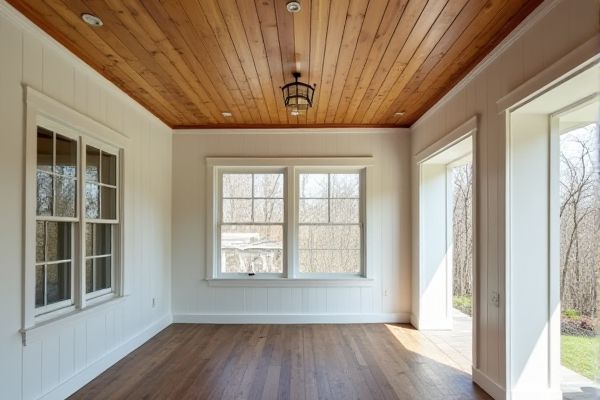
Wood beadboard offers natural warmth and classic charm with excellent paintability but requires regular maintenance to prevent moisture damage on porch ceilings. Vinyl beadboard provides durability, resistance to rot and insects, and low upkeep, making it a practical choice for outdoor spaces; explore the full article to determine which material best suits your porch ceiling needs.
Table of Comparison
| Feature | Wood Beadboard | Vinyl Beadboard |
|---|---|---|
| Material | Natural wood (pine, cedar, or poplar) | Durable PVC vinyl |
| Cost | Higher initial cost | Lower initial cost |
| Installation | Requires nails, priming, and painting | Easy snap-in installation, low maintenance |
| Durability | Susceptible to moisture, may warp or rot | Water-resistant, resists rot and insect damage |
| Maintenance | Periodic painting and sealing needed | Requires minimal cleaning, no painting |
| Appearance | Classic, warm, authentic wood grain | Uniform finish, available in various colors |
| Environmental Impact | Renewable resource, biodegradable | Non-biodegradable plastic, recyclable options limited |
| Longevity | 10-20 years with maintenance | 20+ years with minimal upkeep |
Introduction: Choosing the Right Beadboard for Porch Ceilings
Wood beadboard offers a natural, classic aesthetic with excellent durability and can be painted or stained to match porch designs, while vinyl beadboard provides superior moisture resistance, low maintenance, and easy installation, making it ideal for humid or rainy climates. Wood is prone to warping and requires regular upkeep, whereas vinyl resists rot, mold, and fading over time. Homeowners should consider climate, maintenance preferences, and budget when selecting between wood and vinyl beadboard for porch ceilings.
Material Overview: Wood Beadboard vs Vinyl Beadboard
Wood beadboard is crafted from natural timber, offering authentic texture, warmth, and the ability to be stained or painted for a custom finish. Vinyl beadboard consists of durable PVC, providing moisture resistance, low maintenance, and excellent durability against outdoor elements. You should consider wood for traditional aesthetics and vinyl for cost-effective, weatherproof porch ceiling options.
Aesthetic Appeal and Design Versatility
Wood beadboard offers a classic, warm aesthetic that enhances porch ceilings with natural grain patterns and rich textures, making it ideal for traditional or rustic designs. Vinyl beadboard provides greater design versatility, available in various colors and finishes, and resists moisture and fading, perfect for low-maintenance, contemporary outdoor spaces. Your choice depends on whether you prioritize the authentic charm of wood or the durability and color variety of vinyl.
Durability and Longevity in Outdoor Environments
Wood beadboard offers natural aesthetic appeal but requires regular sealing and maintenance to withstand outdoor elements, as it is prone to rot, warping, and insect damage over time. Vinyl beadboard provides superior durability and longevity in outdoor environments due to its resistance to moisture, mold, and UV rays, making it a low-maintenance option ideal for porch ceilings. Your decision should consider the balance between the classic look of wood and the weather-resistant benefits of vinyl to ensure lasting performance.
Maintenance Requirements and Upkeep
Wood beadboard porch ceilings demand regular maintenance including annual painting or sealing to protect against moisture and wood rot, ensuring long-term durability. Vinyl beadboard requires minimal upkeep, needing only occasional cleaning with mild soap and water to prevent dirt buildup and maintain its appearance. Vinyl's resistance to moisture, mold, and peeling makes it a low-maintenance alternative to traditional wood beadboard.
Cost Comparison: Initial Investment and Long-Term Value
Wood beadboard offers a classic, natural aesthetic with an initial investment typically ranging from $3 to $7 per square foot, while vinyl beadboard costs between $1 and $4 per square foot, making it more budget-friendly upfront. Over time, vinyl beadboard provides greater long-term value due to its resistance to moisture, rot, and insects, reducing maintenance and replacement expenses associated with wood. Choosing vinyl can protect your porch ceiling investment by ensuring durability and low upkeep, whereas wood may require periodic painting and repairs that increase lifetime costs.
Installation Process and DIY Friendliness
Wood beadboard for porch ceilings offers straightforward installation with nails or screws, suitable for DIY enthusiasts comfortable with basic carpentry and finishing work like sanding and painting. Vinyl beadboard features a lightweight, interlocking panel system that can be quickly installed without specialized tools, making it highly DIY-friendly and resistant to moisture and rot. Both materials provide distinct advantages, with vinyl being easier to handle for beginners and wood offering a traditional, customizable finish.
Resistance to Moisture, Insects, and Weather
Wood beadboard offers natural charm but is more susceptible to moisture damage, insect infestation, and weathering, requiring regular maintenance and sealing to prevent warping and rot. Vinyl beadboard provides superior resistance to moisture and insects due to its non-porous material, making it ideal for humid or rainy porch ceilings without the risk of mold or termite damage. Its weather-resistant properties ensure long-lasting durability with minimal upkeep compared to traditional wood options.
Environmental Impact and Sustainability
Wood beadboard offers a natural and biodegradable option with lower embodied energy, supporting sustainable forestry practices when sourced responsibly. Vinyl beadboard involves petroleum-based materials, contributing to higher carbon emissions and non-biodegradable waste that impacts landfills. Choosing wood for your porch ceiling reduces environmental impact and aligns better with eco-friendly building goals.
Final Verdict: Selecting the Ideal Beadboard for Your Porch Ceiling
Wood beadboard offers a classic, warm aesthetic with natural grain patterns and can be painted or stained for customization, making it ideal for traditional porch ceilings. Vinyl beadboard provides superior moisture resistance, low maintenance, and durability against weather conditions, perfect for humid or rainy climates. Selecting the ideal beadboard depends on balancing aesthetic preferences with environmental factors; wood suits dry, covered porches while vinyl excels in exposed, high-humidity areas.
 homyna.com
homyna.com